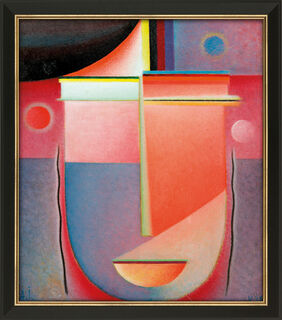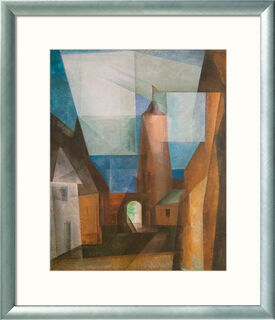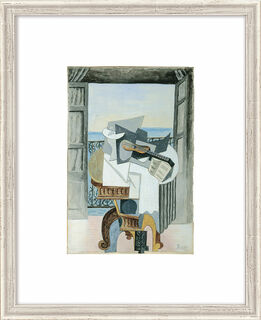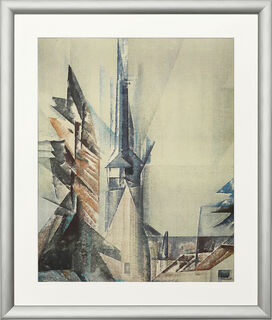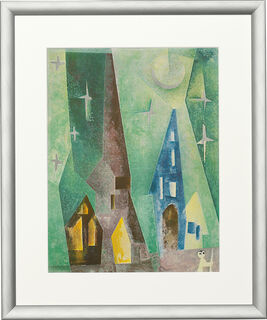Cubism
Cubism - A Modern Imagery of the Early 20th Century
Rectangles, spheres, cones, cylinders, and triangles - according to Cubism, that's all it takes to create motifs on canvas. This epoch brought ground-breaking innovations to painting in the early 20th century and set the course for Classical Modernism and Abstraction. Cubist artists broke rigorously with the prevailing conventions of composition and form shaping at their time. Instead of attempting to depict objects realistically, pioneers such as Pablo Picasso and Georges Braque reduced their expressive language essentially to geometric objects, from which they could compose all sorts of motifs, from landscapes and portraits to still lifes. In addition to Picasso and Braque, important artists of Cubism include Juan Gris, Robert Delaunay, and Lyonel Feininger. Even after the peak of Cubism in the late 1910s, this style had a decisive influence on many of the following art epochs such as Expressionism, Dadaism and Futurism, and later Surrealism and Pop Art. Many varieties of abstract painting are inspired by Cubism at their core. The influence of Cubism painting can be traced right up to current contemporary art. You can buy works of Cubism at ars mundi.
The Origins of Cubist Painting
The origins and development of Cubism painting are closely linked to the artistic biographies of Pablo Picasso and Georges Braque. Both were searching for new forms of expression in painting at the beginning of the 20th century. They considered the traditional painting style of their contemporaries with a clearly defined foreground, background, central perspective, and the postulate of a spatially and plastically correct representation, as too restrictive. To create a new painting style, the two Cubist artists drew inspiration from various tendencies in the painting of their time. Picasso was inspired by Paul Gauguin and Henri Rousseau, among others, as well as by African art. Meanwhile, Georges Braque was fascinated by the works of Henri Matisse and the art of Fauvism. However, many important impulses originated from an impressionist artist: Paul Cézanne. By the end of the 19th century, he had already distanced himself from academic art and was experimenting with new colour spaces and perspectives. His principle, that ultimately all forms of nature could be traced back to geometry, became a manifesto for artists of Cubism. Inspired by these progressive art ideas, Picasso, and Braque initially independently, and later collaboratively, developed the foundations of Cubism. The work "Les Demoiselles d'Avignon", presented by Picasso in 1907, is considered a milestone for this style. This painting already showed some central Cubist characteristics. Picasso defined the bodies of the five women with many right angles, angular shapes, and geometric surfaces. He used few and subdued colours and neglected any depth of space. With this masterpiece, Picasso effectively initiated the official start of Cubism.
The Cubism Characteristics: Picture Composition of Geometric Shapes
Cubism developed in two major phases, each with its own emphasis and characteristics, leading today's art history to distinguish between Analytical Cubism and Synthetic Cubism. After Picasso and Braque had laid the foundations with their ideas, Analytical Cubism emerged as the first phase. Cubist artists basically painted figuratively, but they depicted their motifs using geometric shapes such as rectangles, triangles, circles, cylinders, or rhombuses. Cubist paintings were no longer divided into background and foreground, instead, the pictorial elements were juxtaposed on the same level. The Cubist artists abandoned the central perspective, opting for an all-view perspective, i.e., they depicted the pictorial objects from several perspectives simultaneously. In addition, colour became less important, and the Cubists used only a small and rather pale palette of colours.
In the second stage, Synthetic Cubism, the multi-view of the objects remained, but the artists moved even further away from the objects. Instead of reproducing real objects with geometric bodies, the artists of Cubism now constructed new pictorial objects with their imagery. In addition, the artists again placed more emphasis on colours and painted with stronger tones in a greater variety. The principle of composition and the regained emphasis on colour were also reflected in the technique of collage, which also developed during this time. Some Cubist artists began to apply other materials such as newspaper cuttings, textiles, wood, glass, or sand to the canvas in addition to paint and used these set pieces to create their pictorial objects. Some stylistic features from both phases of Cubism were later found in the works of Expressionist artists of the groups "Brücke" and "Blauer Reiter", as well as the Constructivists and various forms of abstraction. You can buy paintings from these important epochs at ars mundi.

